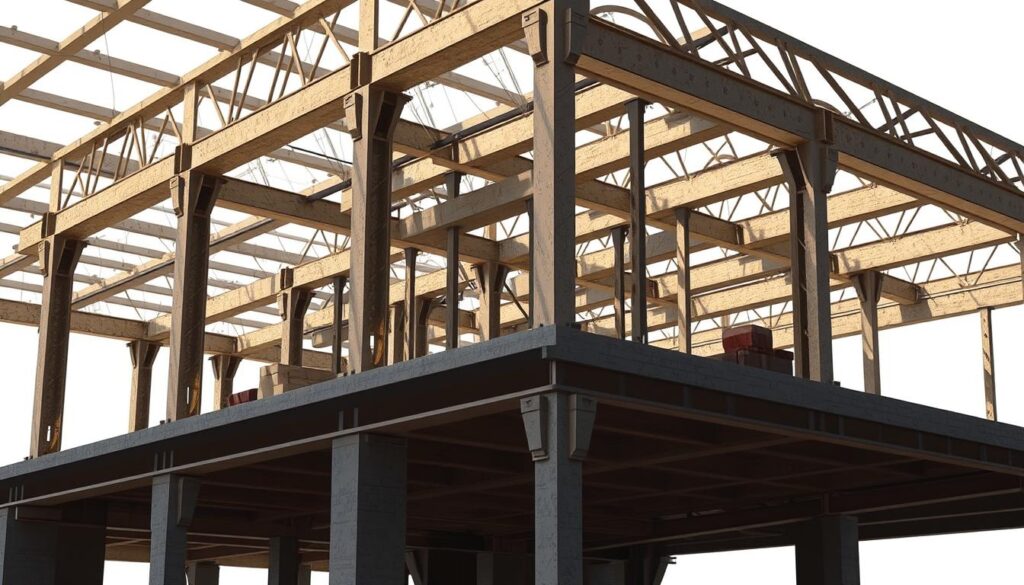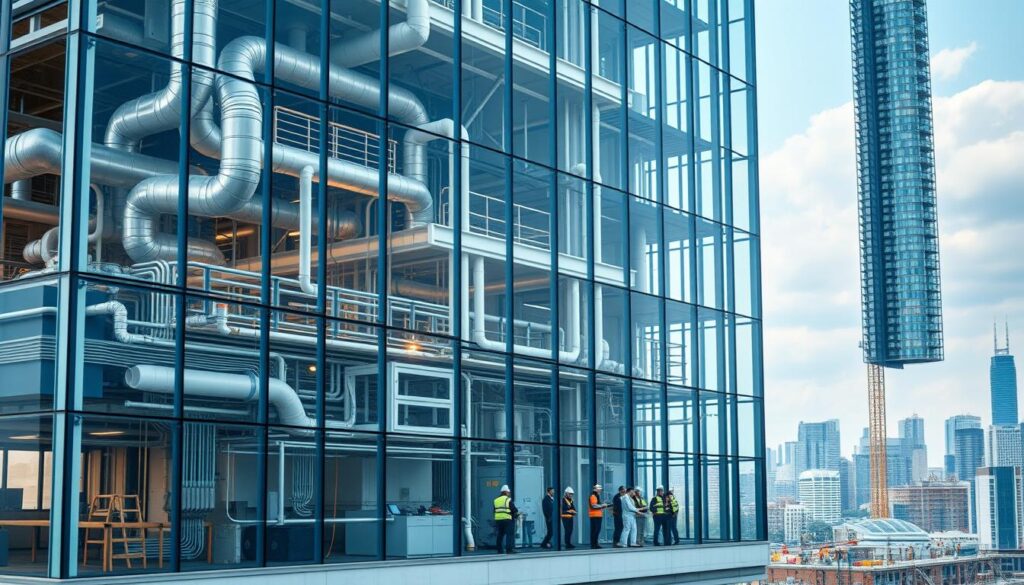Bridging the gap between design and construction, architectural engineering plays a vital role in creating innovative and functional buildings.
By combining the principles of engineering and architecture, professionals in this field bring blueprints to life through technical knowledge and creativity.
The process involves careful structural analysis and a deep understanding of building construction methods to ensure that designs are not only aesthetically pleasing but also safe and sustainable.
As the industry continues to evolve, sustainable design practices are becoming increasingly important, driving the development of new architecture design technologies and materials.
Key Takeaways
- Architectural engineering combines engineering principles and architecture to design and construct buildings.
- Sustainable design is a key aspect of modern architectural engineering.
- Structural analysis is crucial for ensuring the safety and integrity of buildings.
- The field involves bringing blueprints to life through technical knowledge and creativity.
- Advancements in building construction and materials are driving innovation in the industry.
The Fusion of Art and Science in Building Design
In the realm of building design, art and science converge to create structures that inspire and endure. This fusion is at the heart of architectural engineering, a discipline that requires a deep understanding of both the creative and technical aspects of building design.
Defining the Discipline and Its Scope
Architectural engineering is a field that merges artistic vision with scientific methodology to bring buildings to life. It encompasses a broad range of activities, from the initial design phase through to the construction and maintenance of buildings. The scope of architectural engineering includes not just the aesthetic appeal of a structure but also its functionality, sustainability, and safety.
The discipline involves a comprehensive understanding of building systems, including mechanical, electrical, and plumbing (MEP) systems, as well as structural systems. Architectural engineers must be adept at using various tools and technologies, such as building information modeling (BIM) and computer-aided design (CAD) software, to design and analyze building systems.
The Interdisciplinary Nature of Building Design
Building design is inherently interdisciplinary, requiring collaboration between architects, engineers, contractors, and other stakeholders. This collaborative approach ensures that buildings are not only visually appealing but also safe, efficient, and sustainable.
“The built environment is a reflection of our society, and as such, it must be designed with both the present and future in mind.”
The interdisciplinary nature of building design is further illustrated by the following table, which highlights the key roles and responsibilities of various professionals involved in the building design process.
| Professional | Role | Responsibilities |
|---|---|---|
| Architects | Design | Aesthetic appeal, functionality, and spatial planning |
| Architectural Engineers | Technical Design | MEP systems, structural systems, and building performance |
| Civil Engineers | Structural Integrity | Foundation design, structural analysis, and site planning |
By integrating the expertise of various professionals, the building design process can result in structures that are not only functional and efficient but also beautiful and sustainable.
The Evolution of Architectural Engineering Through History
The evolution of architectural engineering is a testament to human ingenuity, reflecting advancements in architectural science and technology. This field has a rich history that spans thousands of years, from ancient structures to modern marvels.
From Ancient Structures to Modern Marvels
Architectural engineering has its roots in ancient civilizations, where monumental structures like the Pyramids of Giza and the Colosseum were built using rudimentary yet effective building materials and construction engineering techniques. As societies evolved, so did the complexity and scale of architectural projects, leading to the development of new materials and technologies. The Industrial Revolution marked a significant turning point, introducing iron and steel into building design, which enabled the construction of larger, more complex structures.

Pivotal Innovations That Transformed the Field
Several pivotal innovations have transformed architectural engineering. The development of reinforced concrete, for instance, allowed for greater flexibility in design and improved structural integrity. Advances in structural engineering have also played a crucial role, enabling the creation of taller, more complex buildings. Moreover, the advent of computer-aided design (CAD) software has revolutionized the field, allowing for precise planning and simulation.
| Innovation | Impact |
|---|---|
| Reinforced Concrete | Improved structural integrity and design flexibility |
| CAD Software | Enhanced precision in planning and simulation |
| New Building Materials | Increased durability and sustainability |
Architectural Engineering in the Digital Age
Today, architectural engineering is in the digital age, with tools like Building Information Modeling (BIM) enhancing the design and construction process. BIM allows for the creation of detailed digital models, facilitating better collaboration among stakeholders and improving project outcomes. The integration of urban development principles into architectural engineering ensures that modern buildings not only meet current needs but are also sustainable for the future.
As the field continues to evolve, it is likely that we will see even more innovative applications of technology and science in architectural engineering, shaping the urban landscapes of tomorrow.
The Blueprint-to-Building Process
Bringing a building design to life involves a meticulous process that spans from initial planning to the final construction phase. This complex journey is crucial in ensuring that the final product meets the desired specifications and quality standards.
Conceptual Design and Initial Planning
The first stage of the blueprint-to-building process is conceptual design and initial planning. During this phase, architects and engineers collaborate to develop the project’s overall vision and objectives. This stage involves feasibility studies, site analysis, and the creation of preliminary designs that outline the project’s scope and potential challenges.
Detailed Design Development
Following the initial planning, the next stage is detailed design development. Here, the preliminary designs are refined, and detailed drawings are created. This phase involves architectural drafting and the integration of various building systems, ensuring that the design is both aesthetically pleasing and functionally sound.
Construction Documentation
Construction documentation is a critical stage where detailed plans and specifications are prepared for the construction team. This documentation includes technical drawings, material specifications, and other relevant details necessary for the construction process.
From Paper to Reality: The Construction Phase
The final stage is the construction phase, where the design is brought to life. Effective construction management and project management are crucial during this phase to ensure that the project is completed on time, within budget, and to the required quality standards. This involves coordinating with contractors, managing resources, and overseeing the construction process.
Throughout the blueprint-to-building process, construction planning plays a vital role in ensuring the project’s success. By carefully managing each stage, from conceptual design to the final construction phase, architectural engineers can deliver high-quality buildings that meet the needs of their clients and stakeholders.
Structural Analysis and Design Fundamentals
Understanding the principles of structural analysis and design is essential for architectural engineers to bring their designs to life safely. Structural analysis and design are critical components that ensure buildings can withstand various stresses and strains, guaranteeing the safety of occupants and the longevity of the structure.

Understanding Building Loads and Forces
Building loads and forces are fundamental considerations in structural analysis. These loads can be categorized into dead loads, live loads, and environmental loads. Dead loads include the weight of the building itself, while live loads encompass the weight of occupants, furniture, and other movable objects. Environmental loads, such as wind and seismic forces, also play a crucial role in determining the structural integrity of a building.
Types of Building Loads:
- Dead Loads
- Live Loads
- Environmental Loads (Wind, Seismic, etc.)
Structural Systems and Their Applications
Various structural systems are employed in building design, each with its unique applications and advantages. Common structural systems include beam and column systems, truss systems, and frame structures. The choice of structural system depends on the building’s purpose, size, and environmental conditions.
| Structural System | Application | Advantages |
|---|---|---|
| Beam and Column | Commercial and Residential Buildings | Flexibility in Design, Easy to Construct |
| Truss System | Roofing, Bridges | High Strength-to-Weight Ratio, Cost-Effective |
| Frame Structure | High-Rise Buildings, Industrial Structures | High Strength, Resistance to Lateral Loads |
Ensuring Structural Integrity Through Calculations
Ensuring the structural integrity of a building involves complex calculations to verify that the structure can withstand various loads and forces. Architectural engineers use advanced software and mathematical models to analyze the structural behavior under different conditions, making adjustments as necessary to ensure safety and durability.
“The art of structure is to eliminate unnecessary parts, making the necessary parts more effective.” – Pier Luigi Nervi
By carefully analyzing building loads, selecting appropriate structural systems, and performing rigorous calculations, architectural engineers can ensure the structural integrity of buildings, ultimately bringing their designs to life in a safe and durable manner.
Building Materials and Construction Technology
Building materials and construction technology play a pivotal role in shaping the built environment, influencing both the aesthetic appeal and the environmental footprint of buildings. The choice of materials and technologies not only affects the structural integrity and durability of a building but also its energy efficiency and sustainability.
Traditional and Innovative Building Materials
Architectural engineers have a wide range of traditional and innovative building materials at their disposal. Traditional materials such as concrete, steel, and wood have been used for centuries, offering proven durability and aesthetic appeal. However, the industry is witnessing a surge in innovative materials like fiber-reinforced polymers, advanced glazing materials, and sustainable composites, which offer enhanced performance and reduced environmental impact.
The development of new materials is driven by the need for sustainability, energy efficiency, and improved building performance. For instance, green building materials are designed to minimize environmental impact through their use of recycled content, low VOC emissions, and sustainable sourcing.
Material Selection for Performance and Sustainability
The selection of building materials significantly impacts a project’s sustainability and performance goals. Factors such as durability, energy efficiency, recyclability, and lifecycle cost are considered when choosing materials. Moreover, the use of locally sourced materials can reduce transportation-related emissions, supporting the project’s overall sustainability objectives.
Material selection also involves considering the building’s intended use, climate, and environmental conditions. For example, materials used in coastal areas must be resistant to saltwater corrosion, while those in high-temperature regions should have high thermal resistance.
Construction Methods and Techniques
Advances in construction methods and techniques have transformed the building process, enhancing efficiency, quality, and safety. Techniques such as prefabrication and modular construction allow for faster assembly and reduced on-site labor, minimizing waste and environmental disruption.
The adoption of Building Information Modeling (BIM) and other digital tools has also improved construction planning and execution. These technologies enable precise coordination among stakeholders, reducing errors and improving overall project outcomes.
Architectural Engineering: Systems Integration
Architectural engineering relies heavily on systems integration to bring complex building designs to life. This critical aspect involves coordinating various building systems to create cohesive and functional building environments.
Mechanical, Electrical, and Plumbing (MEP) Systems
Mechanical, Electrical, and Plumbing (MEP) systems are fundamental components of modern buildings. MEP engineering ensures that these systems are designed and installed to provide a comfortable, safe, and healthy indoor environment. Effective MEP systems integration requires careful planning and coordination to avoid clashes and ensure optimal performance.
The complexity of MEP systems demands a comprehensive approach to design and installation. By leveraging BIM technology, engineers can create detailed digital models that facilitate clash detection and resolution during the design phase, reducing the risk of costly rework during construction.
Creating Cohesive Building Environments
Creating cohesive building environments involves integrating various building systems to achieve a unified and functional space. This integration encompasses not only MEP systems but also other critical systems such as structural and architectural elements. By ensuring that all these components work together seamlessly, architects and engineers can create buildings that are not only aesthetically pleasing but also highly functional and efficient.

Building Information Modeling (BIM) in Systems Integration
BIM technology has revolutionized the field of architectural engineering by enabling more efficient collaboration and clash detection during the design and construction phases. By creating detailed digital models of building systems, BIM facilitates the identification and resolution of potential conflicts before they become major issues on the construction site.
| BIM Benefits | Description | Impact on Systems Integration |
|---|---|---|
| Enhanced Collaboration | BIM enables real-time collaboration among stakeholders. | Improves coordination among different disciplines. |
| Clash Detection | BIM identifies potential clashes in the design phase. | Reduces costly rework during construction. |
| Detailed Modeling | BIM creates detailed digital models of building systems. | Facilitates precise planning and execution. |
Sustainable Design and Green Building Practices
As the world shifts towards more eco-friendly practices, sustainable design and green building practices are becoming increasingly crucial in architectural engineering. The focus is on creating buildings that not only minimize environmental impact but also provide healthy and productive spaces for occupants.
The principles of environmentally friendly design are foundational to sustainable building practices. This involves using materials and techniques that reduce the environmental footprint of buildings. For instance, using locally sourced materials can significantly reduce transportation emissions.
Principles of Environmentally Friendly Design
Environmentally friendly design is guided by several key principles, including energy efficiency, water conservation, and the use of sustainable materials. These principles are applied throughout the design and construction process to minimize the building’s impact on the environment.
One of the critical aspects of environmentally friendly design is the selection of materials. Materials that are recycled, recyclable, or sustainably sourced are preferred. Additionally, designing for longevity and adaptability can reduce the need for future renovations or demolitions.
| Material | Sustainability Features | Environmental Benefits |
|---|---|---|
| Recycled Steel | Recyclable, durable | Reduces waste, conserves natural resources |
| Bamboo | Fast-growing, renewable | Highly sustainable, low environmental impact |
| Low-VOC Paints | Low volatile organic compounds | Improves indoor air quality, reduces health risks |
Energy Efficiency Strategies and Technologies
Energy efficiency is a critical component of sustainable design. This involves using technologies and strategies that reduce the energy consumption of buildings. Some effective strategies include the use of LED lighting, high-efficiency HVAC systems, and smart building technologies.
Renewable energy systems, such as solar and wind power, can significantly reduce a building’s reliance on non-renewable energy sources. Energy-efficient design not only reduces operational costs but also contributes to a reduction in greenhouse gas emissions.
“The green building movement is not just about being green; it’s about being smart, efficient, and sustainable.” –
Environmental Impact Assessment and Mitigation
Conducting an environmental impact assessment is crucial in identifying potential environmental risks associated with a building project. This assessment informs the development of mitigation strategies to minimize these impacts.
Mitigation strategies may include measures to reduce waste during construction, implementing stormwater management systems, and designing buildings to withstand natural disasters. By proactively addressing environmental concerns, architects and engineers can significantly reduce the ecological footprint of their projects.
In conclusion, sustainable design and green building practices are integral to modern architectural engineering. By embracing environmentally friendly design principles, leveraging energy-efficient technologies, and conducting thorough environmental impact assessments, the industry can continue to evolve towards a more sustainable future.
Digital Tools Transforming Design and Construction
The integration of advanced software in architectural drafting is redefining the boundaries of building design. This transformation is largely driven by digital tools that enhance precision, efficiency, and creativity in the design process.

CAD and Revit Software in Architectural Drafting
CAD (Computer-Aided Design) software has become a cornerstone in architectural drafting, allowing for the creation of precise 2D and 3D models. Revit software, a Building Information Modeling (BIM) tool, further enhances this capability by enabling architects and engineers to design buildings and infrastructure with detailed information about their components and systems.
The use of CAD and Revit software streamlines the drafting process, reduces errors, and improves collaboration among project stakeholders. These tools are indispensable in modern architectural practice, facilitating the transition from conceptual designs to detailed construction documents.
Simulation and Analysis Software
Simulation and analysis software play a critical role in testing and optimizing building designs. These tools allow architects and engineers to analyze various aspects of a building’s performance, such as energy efficiency, structural integrity, and environmental impact.
By leveraging simulation software, professionals can identify potential issues early in the design phase, making informed decisions to enhance the building’s performance and sustainability.
Emerging Technologies Shaping the Future of Design
The future of architectural design is being shaped by emerging technologies, including virtual reality (VR) and augmented reality (AR). These technologies offer new ways to visualize and interact with building designs, enhancing the design process and improving communication among stakeholders.
As these technologies continue to evolve, they are expected to have a profound impact on the design and construction industry, enabling more innovative, sustainable, and efficient building practices.
Building Codes and Regulatory Compliance
Compliance with building codes is not just a legal necessity but a crucial step in ensuring the safety and integrity of architectural projects. In the United States, these codes are designed to protect public health, safety, and welfare. Architectural engineers must navigate a complex landscape of regulations that vary by locality, state, and federal jurisdictions.
Navigating Building Regulations in the United States
The United States has a multifaceted system of building regulations, with codes being adopted and enforced at local and state levels. This means that what is compliant in one jurisdiction may not be in another. Design professionals must therefore be adept at understanding and applying the relevant codes for their project’s location. The International Building Code (IBC) and the International Residential Code (IRC) are widely adopted standards that provide a baseline for many local codes.
Code Compliance Strategies for Design Professionals
To ensure code compliance, architectural engineers can employ several strategies. First, staying updated with the latest code revisions is crucial. Utilizing software that is compliant with current codes can also streamline the design process. Additionally, collaborating closely with local building officials during the design phase can help identify and address potential compliance issues early on.
| Code Compliance Strategy | Description | Benefits |
|---|---|---|
| Stay Updated with Code Revisions | Regularly review and understand new code requirements. | Avoids costly redesigns due to code non-compliance. |
| Utilize Code-Compliant Software | Use design software that adheres to current building codes. | Streamlines the design process and reduces errors. |
| Collaborate with Local Building Officials | Work closely with local authorities during the design phase. | Identifies and addresses potential compliance issues early. |
By understanding and implementing these strategies, design professionals can ensure their projects are compliant with relevant building codes and regulations, ultimately contributing to safer and more resilient built environments.
Urban Planning and Infrastructure Development
As cities continue to grow, the importance of effective urban planning and infrastructure development cannot be overstated. These interconnected disciplines are crucial for creating livable, sustainable, and resilient urban environments.
Designing for Community and Context
Urban planning involves designing spaces that foster community interaction and reflect the cultural and historical context of the area. This includes creating public spaces, pedestrian-friendly zones, and mixed-use developments that enhance the urban experience.
Key considerations in community design include accessibility, social equity, and environmental sustainability. By prioritizing these elements, urban planners can create vibrant and inclusive communities.
Infrastructure Planning and Integration
Infrastructure planning is a critical component of urban development, involving the design and implementation of transportation systems, utilities, and public services. Effective infrastructure planning ensures that these systems are efficient, reliable, and capable of supporting the needs of a growing population.
| Infrastructure Type | Key Components | Benefits |
|---|---|---|
| Transportation | Roads, public transit, pedestrian paths | Reduces congestion, promotes mobility |
| Utilities | Water supply, energy grids, waste management | Ensures public health, supports economic activity |
| Public Services | Emergency services, public facilities | Enhances public safety, community well-being |
Sustainable Urban Development Approaches
Sustainable urban development is increasingly important as cities face environmental challenges. Approaches include green building practices, renewable energy integration, and sustainable transportation solutions.

By adopting these strategies, cities can reduce their environmental footprint, improve air and water quality, and create healthier living conditions for their residents.
Case Studies: Bringing Architectural Visions to Life
Architectural engineering case studies provide a window into the challenges and triumphs of bringing complex projects to life. By examining real-world examples, we gain insights into the technical, creative, and logistical considerations that define successful architectural projects.
Innovative Commercial Projects
Commercial projects often push the boundaries of architectural innovation, incorporating cutting-edge design and technology. For instance, the Amazon Spheres in Seattle, Washington, is a prime example of innovative commercial architecture, featuring a unique glass dome structure that houses over 40,000 plants from around the world.
- Innovative glass dome structure
- Incorporation of over 40,000 plants
- Cutting-edge design and technology
Sustainable Residential Developments
Sustainable residential developments are redefining the future of housing, with a focus on environmental sustainability and community well-being. The VanDusen Botanical Garden Visitor Centre in Vancouver, Canada, is a notable example, featuring a living roof and sustainable building practices that minimize its ecological footprint.
- Living roof design
- Sustainable building materials
- Minimized ecological footprint
Landmark Public Buildings and Their Engineering Challenges
Landmark public buildings often present significant engineering challenges due to their scale, design complexity, and the need for public safety. The Sydney Opera House is an iconic example, with its distinctive sail-like design requiring innovative engineering solutions to achieve structural stability and durability.
These case studies highlight the importance of collaboration between architects, engineers, and stakeholders to overcome the challenges and bring architectural visions to life.
The Future of Architectural Engineering
Architectural engineering is on the cusp of a new era, driven by the need for sustainable, resilient, and technologically advanced buildings and infrastructure. This evolution is characterized by the integration of innovative building solutions, smart technologies, and a heightened focus on addressing the challenges posed by climate change and urbanization.
Innovative Building Solutions on the Horizon
The architectural engineering field is witnessing the emergence of groundbreaking building solutions that promise to enhance the functionality, efficiency, and sustainability of buildings. Innovative materials and construction techniques are being developed to reduce environmental impact while improving building performance. For instance, the use of recycled and sustainable materials is becoming more prevalent, reducing waste and the carbon footprint of construction projects.

Smart Buildings and Automation
The rise of smart buildings and building automation systems is transforming the way buildings operate, making them more energy-efficient, secure, and comfortable for occupants. These systems utilize advanced technologies, including IoT devices and data analytics, to optimize building performance and reduce energy consumption. By integrating various building systems, smart buildings can adapt to changing conditions, improving occupant experience and reducing operational costs.
Responding to Climate Change and Urban Challenges
As the world grapples with the challenges of climate change and urbanization, architectural engineers are playing a crucial role in developing buildings and cities that are resilient and adaptable. This involves designing buildings that can withstand extreme weather events, implementing green infrastructure to mitigate the urban heat island effect, and creating sustainable urban planning strategies to reduce the environmental impact of urban development.
By embracing these challenges and leveraging emerging technologies, the future of architectural engineering holds much promise for creating a more sustainable, efficient, and resilient built environment.
Conclusion: The Enduring Impact of Bringing Designs to Life
Architectural engineering is a dynamic field that plays a crucial role in shaping the built environment. By bringing designs to life, architectural engineers create functional, sustainable, and beautiful buildings and spaces that enhance the quality of life for individuals and communities.
The fusion of art and science in building design has led to innovative solutions and advancements in construction, sustainability, and building design. As the field continues to evolve, it will be exciting to see the impact of emerging technologies and trends on the built environment.
The future of architectural engineering holds much promise, with a focus on sustainability, innovation, and responding to urban challenges. By pushing the boundaries of building design and construction, architectural engineers will continue to bring designs to life, creating a lasting impact on our communities and the environment.
